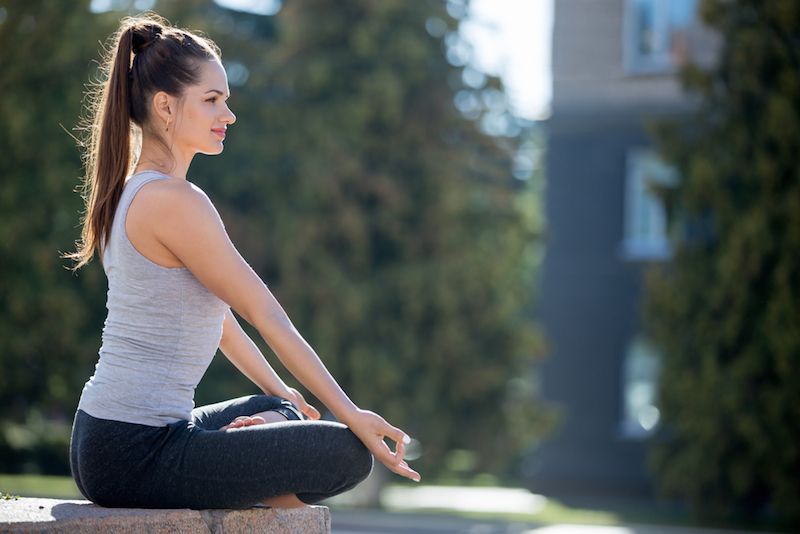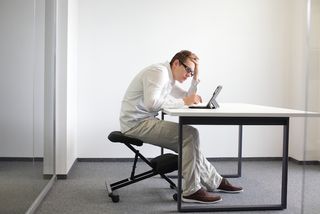Sit Up Straight! How Good Posture Benefits Your Health

Unless you are a ballet dancer or in the military — occupations where poor posture is readily noticed — you probably don't pay much attention to your posture. But if parts of your body — such as the neck, shoulders or lower back — start to cry out in pain, you may find out that your posture is out of whack.
Posture refers to the preferred biomechanical alignment of the body, said Eric Robertson, director of graduate physical therapy education at Kaiser Permanente of Northern California and a spokesperson for the American Physical Therapy Association. Good posture is important because it minimizes the excessive force that muscles and joints need to absorb, he said.
Posture is more than just a function of the way someone stands or sits. For example, it also impacts how much pressure these positions place on the lower back and other muscles and joints. What's more, posture can be a reflection of a person's overall health, fitness, and the body's strength and weaknesses, Robertson told Live Science.
Health effects of posture
There are plenty of reasons to maintain good posture, and doing so can benefit a person's body and mind. [Posture Pointers: 7 Tips for Breaking Bad Habits]
The main health risks of poor posture are aches and pains, which can occur right away or down the road, said Jill Henderzahs-Mason, a wellness physical therapist at the Mayo Clinic's Healthy Living Program in Rochester, Minnesota. This discomfort may start in the neck or back, but ultimately, it may affect the hips or knees, she said.
People who exhibit bad posture also may be less efficient when they move, Henderzahs-Mason said. "They don't move as well or as fast, and are predisposed to injury," she said.
Sign up for the Live Science daily newsletter now
Get the world’s most fascinating discoveries delivered straight to your inbox.

Posture in which the shoulders are hunched forward can even impact breathing, because the diaphragm and the lungs have less room to expand, and this narrows the airways, Henderzahs-Mason told Live Science.
There are many other benefits of standing or sitting up straight. For one, it can help people appear taller and feel better about themselves. Psychology studies have suggested that slouchier postures make people look less confident to others, and even feel less competent, Henderzahs-Mason said. There's also some evidence showing that people who walk with a slouched posture have a higher predisposition to depression than those who walk more upright, she noted.
Research also has shown that slumping and slouching may influence a person's thoughts and feelings, and that improving posture could help to boost mood and energy levels.
Common posture mistakes
There are many factors in people's daily lives that can sabotage posture and throw the body off-balance, such as sitting at a desk for long periods, frequently cradling a phone between the ear and the shoulder, hunching over a laptop, or continually looking down at a smartphone.
The body was not physiologically designed to stay in one position, and if you go a long time without changing your position, it can start to stress your body's tissues, Robertson said. To remedy this common posture mistake, he recommended switching positions about every 20 minutes. For example, you can take a break from your desk work to get up and stretch.
When women wear high heels, their posture can be shifted forward, causing the lower back to arch too much, Robertson said.
Another common problem is when people carry heavy backpacks or bags on one side of the body, which can lead to muscle imbalances, such as muscle tightness or weakness, Henderzahs-Mason pointed out. [5 Surprising Facts About Pain]

People who are concerned about having poor posture can get it assessed, Robertson said. A physical therapist can evaluate someone's posture to identify what is out of balance and what might be the cause, he said.
A physical therapist may closely watch the way a person walks across a room, to look for any physical imbalances, Henderzahs-Mason said. Sometimes, therapists also take a picture of each patient in front of a posture grid. That photo may offer clues about where treatment needs to focus. For example, it may illustrate that one hip or shoulder is higher than another. It also provides people with important visual feedback about what their posture looks like and what they can do to improve it.
To improve posture, a physical therapist may need to manually correct someone's posture so that a person knows what position his or her body needs to be in, or demonstrate how to do certain exercises that could improve tight muscles or help strengthen them.
Follow Live Science @livescience, Facebook & Google+. Originally published on Live Science.
Cari Nierenberg has been writing about health and wellness topics for online news outlets and print publications for more than two decades. Her work has been published by Live Science, The Washington Post, WebMD, Scientific American, among others. She has a Bachelor of Science degree in nutrition from Cornell University and a Master of Science degree in Nutrition and Communication from Boston University.












